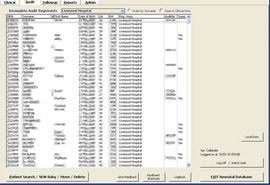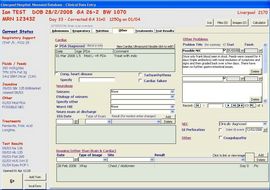PSANZ 2008 Abstract Presented
Development of an Open Source Integrated Clinical and Audit Neonatal Database
Callander I1, Kluckow M 2,
NICUS3
1- Liverpool Hospital Sydney
2- Royal North Shore Hospital Sydney
3- Neonatal Intensive Care Unit Study (NSW & ACT)
NICUS data (includes ANZNN data) has been collected in a purpose built database since the beginning of 2007. This follows an extensive review of data system requirements and methodology at the National Perinatal Data System Planning Workshop in 2004. The new Neonatal Database has been constructed with minimal funding using MS SQL Data Server to house data, and MS Access as the user frontend. The system has been implemented in all 10 member tertiary hospitals with no significant cost required. Data is entered as DateTimed records where possible, using the OHIO (Observational Historical Investigations Outcomes) Principle and Audit Outcomes are then derived. NICUS Data collected since 1992 is archived in the new database and is available for comparative analysis using either the built-in reporting module (graphical outputs included) or powerful adhoc pivot table analysis from MS Excel. Data for other audits including ANZNN can be exported. The Clinical module of the Neonatal Database, is a quasi live data entry system designed to assist in day to day clinical management as well as generate discharge summaries. Initially implemented at Liverpool Hospital, this module is being progressively taken up by other units and has the functionality to manage patients as they move between hospitals. The NICUS Audit Officers have the ability to see auditable clinical data, correct it and lock it after discharge. The Neonatal Database is available for ANZNN member hospitals free of charge, however a strong case can be made for the formation of a consortium allowing for improved development. The open source model allows maximum flexibility and adaptability, but requires local IT support to implement.
You may enlarge the screenshots below in a new window by clicking on them.
| Audit Module: |

|
Subset of the clinical dataset is mainted at a high level of accuracy by the designated audit officer. It can be seen whether the clinical discharge summary has been completed (the notes are no longer needed) |

|
The mode of data entry is very similar to the clinical module, but is cut down in
quantity. Respiratory and Feeding outputs are able to be seen before final closure and locking of the baby record with the generation of a new record in the audit table (calculated summary data outputs). |
| Followup Module: | |

|
The Followup module has been created specifically for the follow-up of premature infants according the the requirements of NICUS NSW. The list shows clinic appointments in chronological order. Assessments of Growth and Development are recorded here to enable the association of outcome data with inpatient data. |
| Reports Module: | |

|
As this database is capable of having data from multiple institutions (linked live
OR imported) there needs to be thought about who should be able to see data from
outside the users intitution. SQL server has security capabilities that make this
very straight forward. Outputs can be separated as local or pooled with other institutions. It is also very easy to have and Excel spreadsheet that is dynamincally linked to a query within the database that allows specific reports to certain users. |

|
Monthly Unit Report with calculated occupancy broken down by level of care. |

|
Benchmarking between hospitals (large scale comparison of audit data) This interface is extremely powerful and enables complicated analysis from within the module. Of course adhoc reporting is still possible using a query analyser tool. |

|
Line charts (customisable for Year or Gestation on X axis) also available as well as bar charts. If these charts are copied and pasted into other office applications (Word, Excel, Powerpoint) then the data is also within the object (ie not just a graphic) |
| Admin Module: | |

|
Update user access, hospital defaults, change lookup tables, enter SQL code (able to make backend structural changes from here) plus access to the actual tables, forms and code (if permission allows). |
| Electronic Logbook: | |

|
This is currently set up for medical staff to log procedures, counselling and education
sessions (linked to the actual procedure within the database wherever possible).
There is no reason this could be broadened to non-medical staff. The logbook can be exported to an excel spreadsheet for transportability. |
| Data Queries from external applications: | |

|
It is easy to connect to the data (with permission) from outside the database. Shown here is an Excel spreadsheet that displays a PivotTable and Chart. The chart can be sent as it is to anyone however if the spreadsheet can connect to the SQL Server (with permission) then the data can be refreshed and the table manipulated; then if you double click on a grouping the individual babies can be displayed (you have to see it live to believe it). |
| Follow-up and Family Support Modules: | |

|
The Followup module and Family Support module have been implemented for specialised
purposes and can be used as a template for those who would like to create an add-on
module for themselves. Each hospital can configure which assessment tools will be administered at their institution and make them available. The growth measures continue from the inpatient period and are graphed with centile charts against corrected age. |
If your hospital uses the 'Obstetrix' database (Australia only), we have commissioned a one-way import program (perinatal data seeds a new record in the Neonatal Database) - contact Dr Martin Kluckow for details (one off payment AU$1000 required to retrieve initial outlay)




















